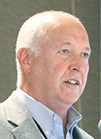By BETSY TAYLOR
SAN DIEGO — U.S. health care venture fundraising totals more than $9 billion annually and health care systems are contributing a growing portion of that amount. Three venture investment executives provided insight at the 2018 Catholic Health Assembly about models to support such investing and strategies for success in the field.

Potter
Mary Jo Potter is founder and chief executive of California-based Healthcare Angels, which has offices in San Francisco and Palo Alto. At the assembly and as co-author of a March 2018 article "Improving Performance and Enhancing Innovation with Venture Investing" published in hfm Magazine she outlined factors for successful venture investment by health systems. Potter is also a senior advisor for Miami-based BDC Advisors.
She said it requires tight alignment between investment strategies and corporate goals. It involves using syndication (joint investment) to partner with other investors who share in successes and downside risk. It's prudent to separate investment activities from operations to maintain investment discipline. This is often done by using a team of investment professionals separate from the system's service line executives. At the same time though, investment professionals should further the system's strategic goals through their investments in the development of relevant products and services.
She said there is benefit in engaging health system leadership in venture investment decisions. Leaders often contribute insights that change or improve a venture.

Hermann
Matthew Hermann, senior managing director of Ascension Ventures, said their for-profit health care venture fund has more than $800 million in capital under management. St. Louis-based Ascension Ventures has 13 limited partners and shares its portfolio companies' services and products across its limited partner base. It seeks financial return and strategic value, he said, and is highly selective about what it funds. He said Ascension Ventures reviews about 300 proposed deals a year and invests in four to six of them.

Randolph
A different venture investment model is used by the La Palma, Calif.-based Innovation Institute. Joe Randolph, its president and chief executive, explained the for-profit has six nonprofit health systems — many of them Catholic — as equity investors known as member owners. It has a lab for innovation; an enterprise development group with institute-owned companies that sell shared services; and it is a member in a health venture fund, which also has other health systems as investors.
Hermann and Randolph said part of the work they do is educating health systems about differences in how start-ups and new ventures work and how the process and time line differ from those that health care system executives are accustomed to. To innovate, businesses often need to pilot venture projects quickly, something health care systems may be unaccustomed to doing. Then, even with a successful pilot, it often takes five to seven years for a return on a venture investment product, service or business.
Copyright © 2018 by the Catholic Health Association
of the United States
For reprint permission, contact Betty Crosby or call (314) 253-3490.